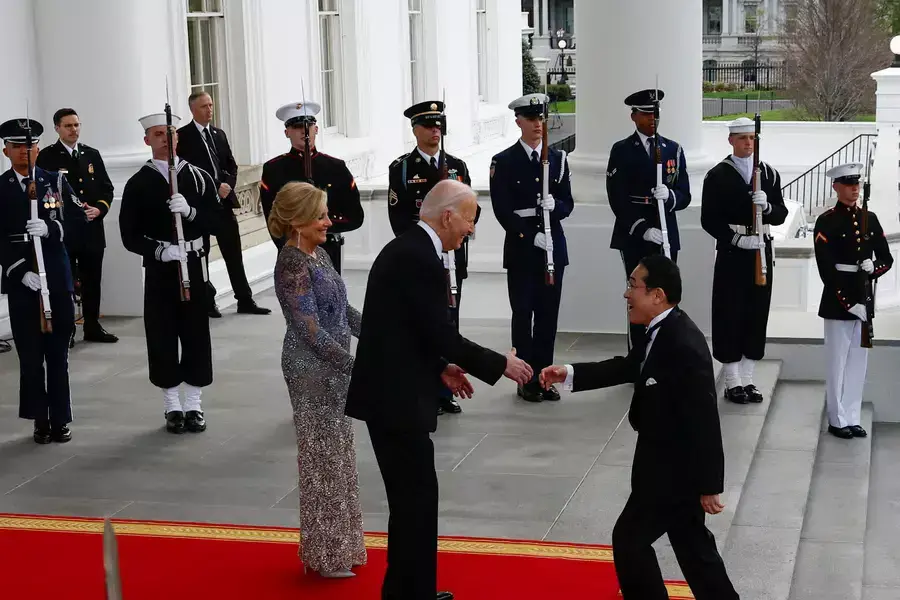Prime Minister Kishida’s Tour de Force

Japan’s prime minister, Kishida Fumio, had a busy week in Washington. The meeting with President Joe Biden produced a Joint Statement, and a list of over 70 “deliverables.” Prime Minister Kishida addressed a Joint Session of Congress. He enjoyed a State Dinner, where Paul Simon sang and attendees reportedly danced. Lunch, hosted by Vice President Kamala Harris and Secretary of State Antony Blinken, was perhaps more restrained but nonetheless full of song and friendship. On Friday, the prime minister headed south to North Carolina, showcasing Japan’s investment in the United States and its commitment to contributing to the U.S. economy.
Kishida looked relaxed and at home throughout. He has had a long relationship with the president, going back to the Obama years but intensified during the Biden presidency as the world erupted in war. The Biden team spared no opportunity to express how Team U.S.-Japan has evolved. The Joint Statement issued by the president and prime minister was over 12 pages long, a testament to just how much work the United States and Japan have to say about the world and their commitment to addressing its challenges together.
More on:
The United States and Japan: Yabba Dabba Doo!
On Capitol Hill, Kishida received a warm welcome, and his speech, I am told, garnered no less than 17 standing ovations. The prime minister emphasized the friendship between Japan and the United States and recalled his youth in Queens as a formative time for his love for the United States. Later, senior U.S. officials took note of his reference to his younger self encountering America, noting how strange and funny he found The Flintstones as a little Japanese boy, “I still miss that show. Although I could never translate ‘yabba dabba doo.’”
But Kishida was ready to embody that yabba dabba doo spirit in the U.S.-Japan partnership. His message was clear: the world needs U.S. leadership. He encouraged continued support for Ukraine; he argued for attention to the China challenge. But most of all, he wanted to encourage Americans and assure them that Japan takes its role as the United States’s closest ally seriously. “Together we carry a large responsibility. I believe that we are essential to peace…vital to freedom…and fundamental to prosperity.” In short, he told Congress that Japan and the United States were “global partners for the future.”
The Highlights
So much was announced last week for the U.S.-Japan agenda. But here are a few highlights that caught my eye.
More on:
Our militaries are upgrading their ability to plan operations together.
The U.S. Indo-Pacific Command will designate a commander to interface with the Permanent Joint Operations Command of the Japanese Self-Defense Forces (SDF) to ensure smooth operational command and control. A new Bilateral Information Analysis Cell will be formed to ensure timely exchange of intelligence.
Our young people will get much needed support in building friendships and partnerships.
A new educational exchange endowment of $12 million was created for the Mineta Ambassadors Program in honor of former Secretary Norman Y. Mineta, the first Asian-American to serve in the Cabinet of the United States.
Our technology companies are putting skin in the game for innovation, and our universities are partnering on future AI research.
Microsoft has committed $2.9 billion investment in Japan on AI. U.S. and Japanese universities have teamed up—the University of Washington with the University of Tsukuba and Carnegie Mellon University with Keio University—with funding from government and private sector sources for AI research partnerships.
Our alliance is the basis of expanding regional pushback on China’s attempt to change the status quo.
A Joint Statement issued by the Trilateral Leaders’s Summit with the United States, Japan, and the Philippines announced they would conduct joint maritime patrols, along with climate change, economic resilience, and new infrastructure initiatives
Our astronauts will land on the moon together in the Artemis mission.
A Lunar Surface Exploration Implementing Arrangements was signed. Japan will provide a Japanese pressurized lunar rover and the United States will invite two Japanese astronauts to join future Artemis missions to explore the lunar surface.
Japanese FDI in the United States continues to grow.
On his last day here, Prime Minister Kishida visited North Carolina. Governor Roy Cooper designated it “North Carolina and Japan Friendship Day.” Kishida toured two factories in North Carolina where nearly 30,000 residents are employed by Japanese companies. Kishida also visited the Honda Aircraft Company and a new Toyota EV battery factory due to open in 2025, a $13.9 billion investment.
 Online Store
Online Store